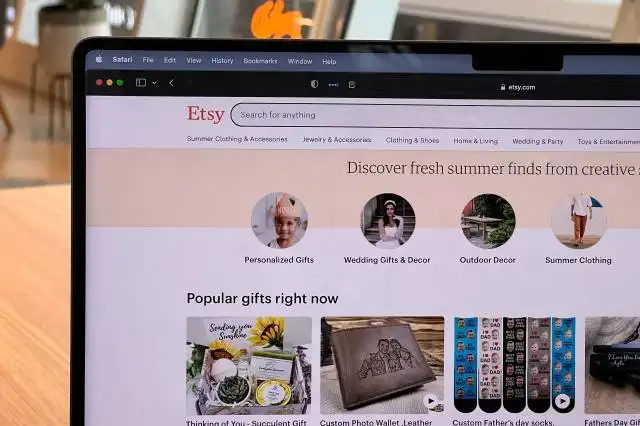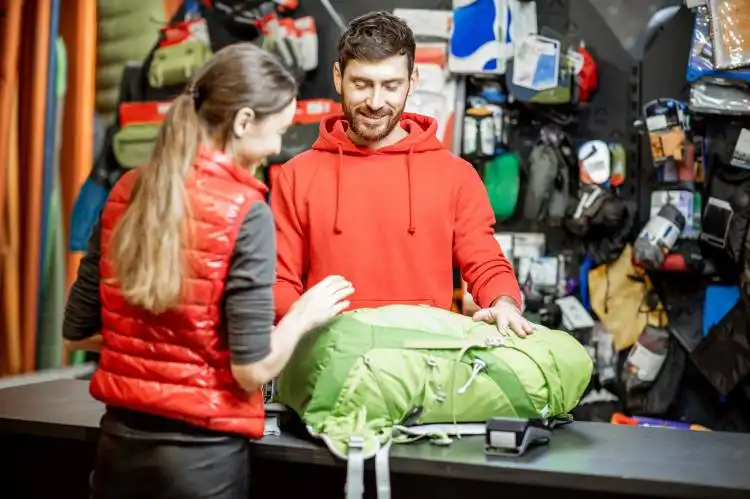Start a Fashion Consulting Business
Wielding Your Style Wand: Becoming the Fairy Godmother of Fashion Consulting
| Updated


FASHION CONSULTING BUSINESS
Unleash your flair for style into the world of entrepreneurship with a Fashion Consulting business! This avenue lets you play the fairy godmother, transforming fashion mishaps into people with enviable style quotients. It operates on the principle of guiding individuals or corporations about their style and fashion choices. It's time to wave your magic wand and transform that plain Jane or Joe next door into the next fashion icon. The fashion distress calls are waiting for you, are you ready to answer?
Jump to Business Plan
RELATED BUSINESS IDEAS
Browse ALL Clothing & Fashion Trends Business Ideas
Discover Your Perfect Domain
Unlock the door to your online success with our hand-picked selection of premium domain names. Whether you're starting a new venture or rebranding an existing one, the right domain can set the tone for your digital presence. Browse through our curated list, each with its unique potential to enhance your brand's visibility and credibility.
FASHION CONSULTING MINI BUSINESS PLAN
This a quick reality check to help you identify the strengths and weaknesses of your business concept before you dive in.
Expected Percent Margin:
- Gross Margin: 30-50%
- Net Profit Margin: 15-20%
Earnings Expectations:
- Daily Earnings: $150 - $400
- Weekly Earnings: $750 - $2,000
- Monthly Earnings: $3,000 - $8,000
- Annual Earnings: $36,000 - $96,000
Actions to Hit Those Numbers:
Branding and Professional Development:
- Credentials: You should have a degree in fashion, retail, or similar subjects, or substantial experience in the fashion industry, and certifications from recognized fashion institutes.
- Professional Portfolio: A well-curated portfolio showcasing your work is crucial for attracting clients.
Marketing and Customer Acquisition:
- Website and Social Media: Create a visually appealing website and active social media presence. Post style tips and fashion trends regularly.
- Networking: Attend fashion events, industry meetups, and collaborate with local boutiques, stylists, and designers to enhance visibility.
Service and Customer Experience:
- Range of Services: You may offer various services such as personal shopping, wardrobe consultation, color and style assessment, special events styling, etc.
- Quality Service: Ensure excellent service and customer satisfaction. A satisfied customer is likely to return and refer others.
Pricing:
- Consultancy Fee: You may charge anywhere between $50 to $500 per hour based on your credentials, services offered, and the region you are based in.
- Revenue Streams: Besides hourly rates, consider additional revenue streams, like commissions from fashion brands, workshops, and talks, collaborations, etc.
Operations:
- Working Hours: As a consultant, you will most likely determine your working hours based on your clients' needs. Weekend and evening hours may be often required.
- Clientele: Aim to build a steady clientele. Maintaining good relationships with clients is key. You may serve anywhere between 3 to 5 clients a day based on the nature of service.
Remember, these are estimations and results depend heavily on your expertise, reputation, marketing efforts, pricing strategies, and location.
NOT WHAT YOU HAD IN MIND? Here are more ideas



Browse ALL Clothing & Fashion Trends Business Ideas
Grab Your Business Website Name
Before you get caught up in the whirlwind of setting up your business, invest in a domain name. It's a small but significant step that lays the foundation for your brand and makes it easier for customers to find and trust you. Just like you wouldn't build a house without securing the land first, don't build a business without securing your domain name.
"Why? Can't that wait?" Here's why it shouldn't
Step 1: Determine if a fashion consulting business is the right endeavor
Breakdown of startup expenses
Starting a fashion consulting business requires a significant investment of time and money. The exact amount of money required to get the business off the ground will depend on the type of services offered, the size of the business, and the location. Some of the startup expenses to consider include the cost of registering the business, obtaining any necessary licenses, purchasing supplies, renting office space, and hiring employees. Additionally, a marketing budget should be allocated to help spread the word about the business and attract customers.
Breakdown of ongoing expenses
Once the business is up and running, there will be ongoing expenses to consider. These can include the cost of salaries for employees, rent for office space, insurance, taxes, and any other costs associated with running the business. Additionally, the business should have a budget for marketing and advertising to help keep the business in the public eye and attract new customers.
Examples of ways to make money
There are a variety of ways to make money as a fashion consultant. These include offering styling services, providing advice on fashion trends and styles, offering personal shopping services, and offering wardrobe consulting services. Additionally, fashion consultants can offer their services to individuals, businesses, or both. They can also offer their services in-person or online.
Step 2: Name the business
Naming a business can be a daunting task, but it is an important step in the process of starting a fashion consulting business. It is important to pick a name that is memorable and reflects the services the business will provide. It is also important to make sure the name is not already taken by another business. A great way to come up with a name is to brainstorm with friends and family, or to use a business name generator. Additionally, it is important to make sure the name is available for use in the state the business will be located in. This can be done by searching the Secretary of State's website for the state. Once the name is chosen, it is important to register the business with the state and secure the domain name. This will ensure the business name is legally protected and the business has a website.
Step 3: Create a business plan
Creating a business plan is an essential part of starting a fashion consulting business. It should include a detailed description of the services you plan to offer, a marketing plan, a financial plan, and a timeline for launching the business. The outline should include the following sections: Executive Summary, Company Description, Market Analysis, Organization and Management, Service or Product Line, Marketing and Sales, Funding Request, Financial Projections, and Appendix.
The Executive Summary should provide an overview of the business, its goals, and its unique selling points. The Company Description should include the business name, location, and contact information. The Market Analysis should include an analysis of the target market and the competitive landscape. The Organization and Management section should include information about the ownership structure and the roles and responsibilities of each team member. The Service or Product Line section should include a description of the services or products offered and how they will be priced. The Marketing and Sales section should include a description of the marketing strategies and tactics that will be used to reach the target market. The Funding Request section should include a description of the funds requested and how they will be used. The Financial Projections section should include a breakdown of expected income and expenses for the first three years of operation. Finally, the Appendix should include any additional information that may be helpful to the reader.
Step 4: Obtain the necessary licenses and permits
In order to legally operate a fashion consulting business, it is necessary to obtain the necessary licenses and permits. Depending on the state, these may include a business license, a sales tax permit, an employer identification number, and a zoning permit. Additionally, if the business will be selling products, a resale permit may also be required. It is important to research the specific requirements for the state in which the business will be operating.
How to obtain the necessary licenses and permits
The process for obtaining the necessary licenses and permits will vary depending on the state in which the business is operating. Generally, the first step is to register the business with the state. This can be done online or in person at the local business office. Once the business is registered, the next step is to apply for the necessary licenses and permits. This can be done online or in person at the local business office. It is important to keep all paperwork related to the licenses and permits in a safe place.
Cost of obtaining the necessary licenses and permits
The cost of obtaining the necessary licenses and permits will vary depending on the state in which the business is operating. Generally, the cost will include the registration fee, the application fee, and any other fees associated with the licenses and permits. Additionally, there may be annual fees associated with the licenses and permits that must be paid in order to keep them active.
Time frame for obtaining the necessary licenses and permits
The time frame for obtaining the necessary licenses and permits will vary depending on the state in which the business is operating. Generally, the process can take anywhere from a few days to a few weeks. It is important to plan ahead and allow enough time for the process to be completed before launching the business. Additionally, it is important to keep track of the expiration dates of the licenses and permits and renew them as needed.
Step 5: Choose a business structure
Choosing the right business structure is an important step in starting a fashion consulting business. There are four main types of business structures: sole proprietorship, partnership, limited liability company (LLC), and corporation. Each structure has its own advantages and disadvantages, so it’s important to understand the differences before making a decision.
Sole Proprietorship: A sole proprietorship is the simplest and most common business structure. It is owned and operated by one individual, and the owner is personally liable for all debts and obligations of the business. This structure is easy to set up and maintain, but it does not provide any personal liability protection.
Partnership: A partnership is a business owned and operated by two or more individuals. The partners share the profits and losses of the business, and each partner is personally liable for the debts and obligations of the business. This structure is relatively easy to set up and maintain, but it does not provide any personal liability protection.
Limited Liability Company (LLC): An LLC is a business structure that combines the advantages of a corporation and a partnership. The owners of an LLC are not personally liable for the debts and obligations of the business, and the business itself is treated as a separate legal entity. This structure is more complex to set up and maintain than a sole proprietorship or partnership, but it provides the owners with personal liability protection.
Corporation: A corporation is a business structure that is owned and operated by a group of shareholders. The shareholders are not personally liable for the debts and obligations of the business, and the business itself is treated as a separate legal entity. This structure is more complex to set up and maintain than a sole proprietorship or partnership, but it provides the owners with personal liability protection.
When choosing a business structure, it is important to consider the tax implications, the amount of paperwork involved, and the personal liability protection offered. It is also important to consult with a qualified accountant or attorney to ensure that the chosen structure is the best fit for the business.
Step 6: Open a business bank account
Opening a business bank account is an important step in setting up a fashion consulting business. It is important to research the different options available and find the one that best fits the needs of the business. It is also important to make sure that the account is FDIC insured, so that the business’s funds are protected. Additionally, it is important to make sure that the account has the features that the business needs, such as online banking and check writing capabilities.
Benefits of having a business bank account
Having a business bank account is important for any business, as it helps to separate the business’s finances from the owner’s personal finances. This makes it easier to track expenses and income, and it also helps to protect the owner’s personal assets. Additionally, having a business bank account can help to establish the business’s credibility with customers, vendors, and other businesses.
Tips on choosing a bank
When choosing a bank for a business account, it is important to consider the fees associated with the account. Some banks may charge monthly fees or minimum balance fees, so it is important to find a bank that has the lowest fees. Additionally, it is important to consider the location of the bank and the customer service offered. It is also important to make sure that the bank offers the features that the business needs, such as online banking and check writing capabilities.
Step 7: Market the business
When marketing your business, it is important to use a variety of strategies to reach potential customers. Examples of marketing strategies include: creating a website, utilizing social media, attending networking events, and creating promotional materials such as business cards, flyers, and brochures. Additionally, you can also use word-of-mouth marketing by asking current customers to refer your services to their friends and family.
Advertising
Advertising is another important part of marketing your business. You can advertise your services on a variety of platforms, including radio, television, print, and online. Additionally, you can also use search engine optimization (SEO) to help your website rank higher in search engine results. This will help potential customers find your business more easily.
Networking
Networking is an important part of marketing your business. You can attend industry events, join professional organizations, and reach out to other fashion professionals to build relationships and spread the word about your business. Additionally, you can also use online networking platforms such as LinkedIn to connect with potential customers and partners.
Public Relations
Public relations is another important part of marketing your business. You can use public relations to create positive press for your business by writing press releases, attending press events, and engaging with the media. Additionally, you can also use public relations to build relationships with influencers and other fashion professionals.
Step 8: Create an online presence
Creating an online presence is essential for any business. It allows potential customers to find you and learn more about your services. It also serves as a platform to showcase your work and attract new clients. Here are some tips on how to create an online presence:
Create a website: A website is the cornerstone of any online presence. It should include information about your services, portfolio, contact information, and any other relevant information. It should also be easy to navigate and have a professional design.
Use social media: Social media is a great way to reach potential customers and build relationships with them. Create accounts on the major platforms such as Facebook, Twitter, and Instagram, and use them to post updates about your services, showcase your work, and engage with customers.
Start a blog: A blog is a great way to share your knowledge and expertise with potential customers. You can use it to post helpful articles, tips, and advice related to fashion consulting.
Utilize SEO: SEO, or search engine optimization, is a great way to make sure your website and social media accounts appear in search engine results. Use keywords related to fashion consulting in your website content and social media posts to help potential customers find you.
Invest in advertising: Investing in online advertising can help you reach a larger audience and attract more customers. Consider using Google Ads, Facebook Ads, or other online advertising platforms to reach potential customers.
Step 9: Hire employees
When it comes to hiring employees for a fashion consulting business, it is important to make sure that the people you hire have the skills and experience necessary to help your business succeed. It is also important to make sure that the people you hire are a good fit for the culture of your business. When hiring employees, consider conducting interviews, running background checks, and asking for references. Additionally, consider offering competitive salaries and benefits to attract the best talent. When it comes to hiring employees, it is important to take your time and make sure you are making the right decision.
EXPLORE MORE CATEGORIES
Browse ALL Business Idea Categories
TAKE THE NEXT STEPS










